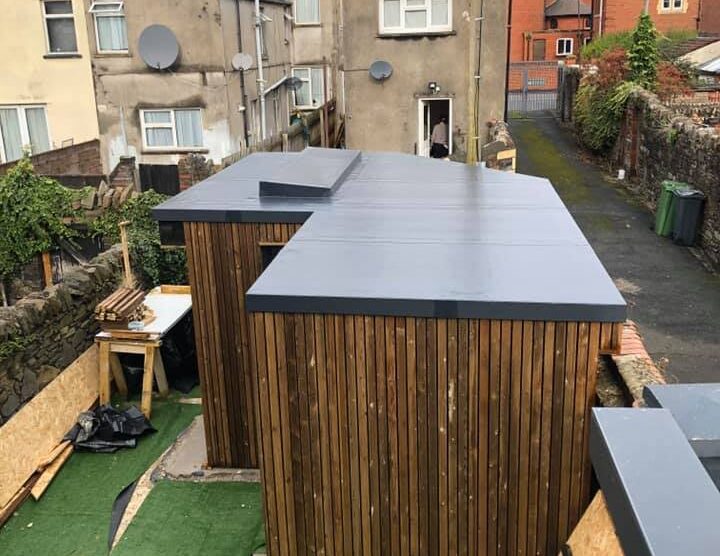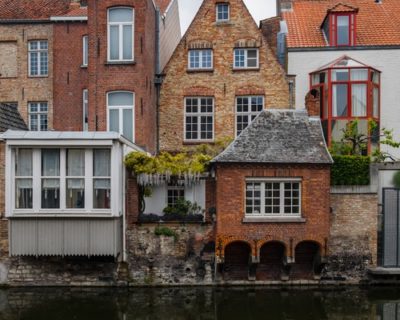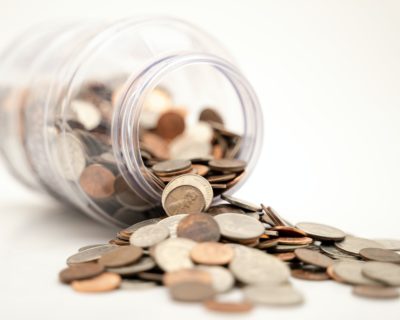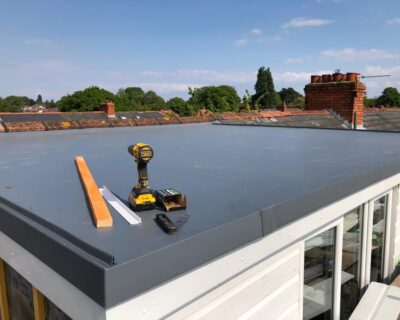Blog & News

What Materials Are Used For a Flat Roof?
Flat roofs are getting more popular every year. As roofs break and need fixing, more and more people are opting for a flat roof rather than a pitched roof. There are a number of reasons for this which we will look into today, and we will also be discussing the best materials to use for a flat roof.
There are more materials that can be used for flat roofs than you might first think, so get ready for some surprises in our list.
Why opt for a flat roof?
Flat roofs get a bad reputation, but we think that this is mostly uncalled for. New materials give flat roofs a new lease of life and make them stronger so that you shouldn’t find too many problems with installing one.
One of the most common reasons why people choose a flat roof over a pitched roof is because they’re faster to build. This not only means that your construction work will kick you out of your home for less time, but it will also reduce the labor costs necessary to pay.
Flat roofs also use fewer materials to build, reducing overall costs as well. Overall, flat roofs are good for people who want to save money on building projects. Flat roofs can be used for both residential and commercial buildings.
Materials used for flat roofs
Speaking of materials, let’s get right into the most common types for flat roofs. We’ll talk about both their advantages and disadvantages so that you can get a well-rounded view of all of your options.
Felt
Felt is the most common flat roof material traditionally used. This is because not as many materials were available for flat roofs before technological advancements allowed more to be created. Felt gets a bad reputation due to the many reports of them leaking and wearing prematurely, but we would remind you that this was true before many contractors have found ways to work around this.
Installing a felt roof is a better investment now as they are unlikely to leak and need a lot of repairs. Felt flat roofs are very inexpensive and can be used for almost any size of the roof. However, the main drawback of a flat roof is that it’s not very easy to repair yourself.
EPDM Rubber
EPDM rubber is a lightweight and flexible material that doesn’t usually need joins to be installed. This can speed up the installation process and get your roof finished at a quicker rate. We know that rubber doesn’t sound particularly safe or sturdy, but EPDM rubber will surprise you in both aspects.
This material can leave your roof long-lasting and gives it the potential to not have to be repaired for up to a century. Rubber roofs are more expensive than felt but not so much that it will put you off immediately. The drawbacks to rubber roofs are that they aren’t great for difficult shaped roofs and they don’t look very pretty once installed.
Asphalt
Asphalt is another material that has been used for many years when it comes to roofs. It’s easy to install in all sorts of shapes and sizes, and it’s difficult to damage. This means that you’ll be able to walk on your roof regularly without the worry of it collapsing underneath your feet.
Asphalt is also inexpensive and easy to repair in case it does falter. The look of asphalt is very simple and it doesn’t draw much negative attention to your roof as a rubber roof does. Asphalt is more expensive than felt roofs and it’s quite heavy so it cannot be installed on top of weak structures.
Fiberglass
Fiberglass is a glass-reinforced plastic and it has seen an increase in popularity over the past few years. Most contractors will consider fiberglass to be their preferred material for building flat roofs, and they can last up to 30 years if built correctly.
Fiberglass is lightweight yet tough so it can be used on any kind of structure, whether it’s weaker or sturdy. These types of roofs can also look very attractive and you can walk on top of them without any worry at all.
If you damage a fiberglass roof, most professionals know how to fix them within a record timing. So, fiberglass flat roofs are quickly becoming the most popular in terms of material.
Types of flat roofing
Single-layer membrane roofing
Most commonly known for commercial roofing, single-layer membrane technology is relatively new. These roofs come in a variety of materials such as neoprene, EPDM rubber, PVC, and chlorinated polyethylene. EPDM rubber is the most commonly used, but all can be found on the market.
These roofs are installed as sheets of material as thin as 3 millimeters thick. They are laid down as a single layer and fastened by an adhesive.
Modified bitumen roofing
A more traditional method of roofing, modified bitumen roofing has been used since the 60s. They are installed by a number of methods such as hot-applied, cold-applied, self-adhered, or torch-applied. The sheets include polymer which allows the roof to be elasticated and flexible.
Built-up roofing
Finally, built-up roofing can be dated back to around 120 years ago, and it’s a marvel that it’s still being used today! This method uses several layers of felt that have asphalt within the material. There is also bitumen embedded within the material.
Once a hot mop touches the felt it creates a thick roof membrane. There is then a layer of small stone granules applied over the top of the roof to protect the material from weathering or UV rays.
Summary
We hope that you’ve learned something valuable about what materials are used for a flat roof. With more and more people opting for flat roofs rather than pitched roofs, it’s important to know what options are available for you to take advantage of.
Fiberglass is becoming increasingly popular as a material for flat roofs, but asphalt, felt, and EPDM rubber can also be used. We would recommend talking to a professional about the options best for your property. For a free estimate, you can call Sureseal Flat Roofing on 01302 302 825.



